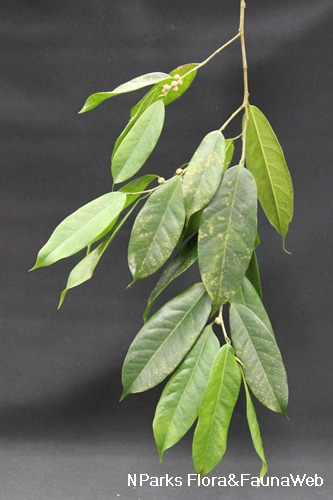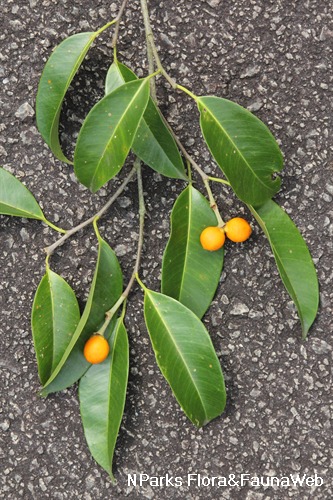.jpg)
Name
Classifications and Characteristics
| Plant Division | Angiosperms (Flowering Seed Plants) (Dicotyledon) |
|---|---|
| Plant Growth Form | Climber |
| Lifespan (in Singapore) | Perennial |
| Mode of Nutrition | Autotrophic |
Biogeography
| Native Distribution | Thailand, Sumatra, Peninsular Malaysia, Singapore, and Borneo |
|---|---|
| Native Habitat | Terrestrial (Primary Rainforest, Secondary Rainforest, Freshwater Swamp Forest) |
| Preferred Climate Zone | Tropical |
| Local Conservation Status | Native to Singapore (Endangered (EN)) |
Description and Ethnobotany
| Growth Form | It is a root-climber, with latex. |
|---|---|
| Foliage | Its alternate, stalked leaves have leathery leaf blades that are oval to egg-shaped, and 10–30 by 4–13 cm. |
| Flowers | The plant is dioecious, with different plants producing male or female flowers enclosed within a specialised structure known as a synconium (or commonly called a 'fig'). |
| Fruit | Its syconia (figs) are solitary or in pairs, borne in the leaf axils, pear-shaped, 4–6.5 by 1.5–2.5 cm, and orange to red, then purple to black when ripe. |
| Habitat | It grows in lowland forests, often in swamp forests. It occurs locally along Mandai Lake Road, in Central Catchment Nature Reserve, and Western Catchment. |
| Associated Fauna | Its flowers are pollinated by fig wasps. The ripe fruits are eaten by frugivorous birds and mammals. |
| Cultivation | It can be propagated by seed and stem cuttings. |
| Etymology | Latin Ficus, the commercial edible fig (Ficus carica); Greek apion, pear; Greek karpos, fruit, referring to its syconia (figs) |
Landscaping Features
| Landscaping | It may be suitable for park and roadsides. |
|---|---|
| Desirable Plant Features | Ornamental Foliage, Ornamental Fruits |
| Landscape Uses | General, Parks & Gardens, Small Gardens |
Fauna, Pollination and Dispersal
| Fauna Pollination Dispersal Associated Fauna | Bird-Attracting (Fruits), Caterpillar Moth Food Plant (Leaves) |
|---|---|
| Pollination Method(s) | Biotic (Fauna) (Insects (Ant, Beetle, Fly, Thrip, Wasp)) |
| Seed or Spore Dispersal | Biotic (Fauna) (Vertebrates (Other Mammal)) |
Plant Care and Propagation
| Light Preference | Full Sun, Semi-Shade |
|---|---|
| Water Preference | Moderate Water |
| Rootzone Tolerance | Moist Soils, Well-Drained Soils |
| Propagation Method | Seed, Stem Cutting (Herbaceous) |
Foliar
| Foliage Retention | Evergreen |
|---|---|
| Mature Foliage Colour(s) | Green |
| Mature Foliage Texture(s) | Leathery |
| Prominent Young Flush Colour(s) | Red |
| Young Flush Texture(s) | Leathery |
| Foliar Type | Simple / Unifoliate |
| Foliar Arrangement Along Stem | Alternate |
| Foliar Attachment to Stem | Petiolate |
| Foliar Shape(s) | Non-Palm Foliage (Ovate, Elliptical) |
| Foliar Venation | Pinnate / Net |
| Foliar Margin | Entire |
| Foliar Apex - Tip | Acute |
| Foliar Base | Cordate |
Floral (Angiosperm)
| Flower & Plant Sexuality | Unisexual Flowers , Dioecious |
| Flower Grouping | Cluster / Inflorescence |
|---|
| Flower Location | Axillary |
| Inflorescence Type | Syconium |
Fruit, Seed and Spore
| Mature Fruit Colour(s) | Black, Orange, Purple, Red |
|---|---|
| Fruit Classification | Multiple Fruit |
| Fruit Type | Fleshy Fruit , Accessory / False Fruit (Pseudocarp) |
Image Repository
Others
| Master ID | 31183 |
|---|---|
| Species ID | 5577 |
| Flora Disclaimer | The information in this website has been compiled from reliable sources, such as reference works on medicinal plants. It is not a substitute for medical advice or treatment and NParks does not purport to provide any medical advice. Readers should always consult his/her physician before using or consuming a plant for medicinal purposes. |



.jpg)



